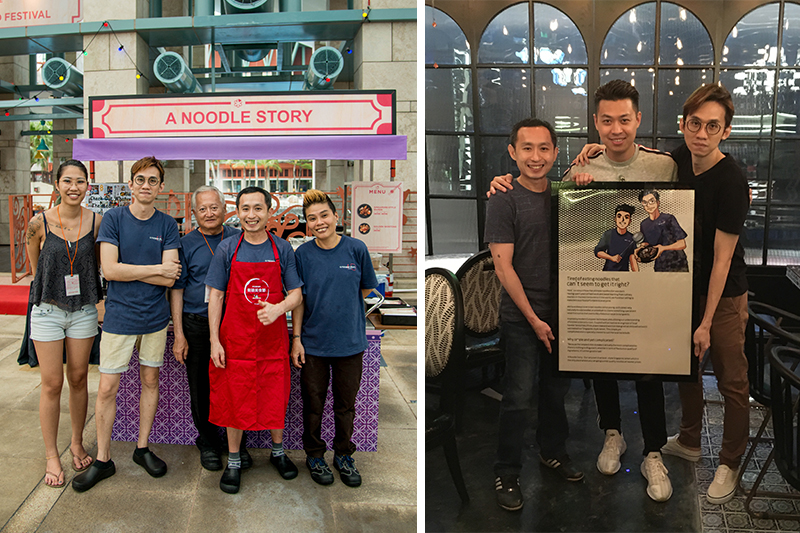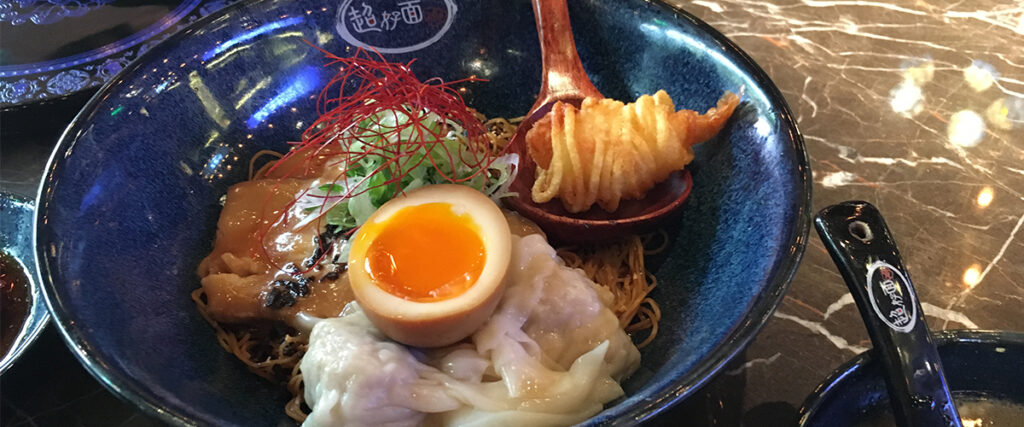Meet Gwern Khoo and Ben Tham, founders of A Noodle Story and the hawkerpreneurs cooking up a storm to preserve Singapore’s prized food culture for future generations to come.
Established in 2013, A Noodle Story is a small stall packing a big punch as it dishes out Singapore-style noodles in the city’s Central Business District’s Amoy Street Food Centre. Think springy noodles, melt-in-your-mouth pork slices and Hong Kong-style dumplings alongside a crispy, potato-wrapped prawn and hot spring egg. With a dedicated daily crowd of customers that snakes down the street at lunch and dinner, a new franchise outlet in Hong Kong and numerous accolades including a Michelin Bib Gourmand Guide, this street food outlet is shaking up Singapore’s traditional hawker culture, proving that, perhaps, there is a way forward for the ways of old.

The success of A Noodle Story comes against the backdrop of a cut-throat F&B industry that has seen many of Singapore’s hawkers winding down their businesses and threatened the very existence of the island’s internationally-renowned, heritage-driven street food culture. For an ageing generation of food sellers, both the physical toll of their trade and a lack of successors has left them with no choice but to call it a day. Millennials aren’t keen to take up the mantle, citing long shifts that range between 12 to 14 hours, less than cosy work environments and low wages as barriers to entry. For Gwern and Ben, however, these challenges weren’t enough to put them off. Instead, they set about updating the hawker model, perhaps showing how to save it in the process.
The duo met in 2006 through a culinary arts programme at the Singapore Hotel and Tourism Education Centre. Their backgrounds couldn’t be more different — Gwern came from the military, while Ben was in construction. Like most Singaporeans, they shared a common love for hawker food, and went on to transition their careers and hold stints at Michelin-starred Waku Ghin and LeVel33 respectively. Fast forward to 2013, and the uptrend of Japanese ramen on home soil inspired Gwern to come up with a concept that combined culinary elements from Singapore, Hong Kong and Japan. Bringing Ben onboard as a partner, the two chefs started their new journey. Cash-strapped and keen to avoid the high start-up costs and failure rate that seemed to plague new restaurants, they chose instead to take inspiration from the hawker scene with a small, more cost-effective setup that offered food appealing to a younger, travel-savvy crowd.

“We’re keeping the flame alive by creating something delicious yet value for money, and showing other hawkers that it is possible to make it in this industry,” explains Gwern. By value for money, he doesn’t mean cheap — A Noodle Story’s offerings start at SGD 8, double the price of typical hawker fare. “For the first two to three years, we sold food at much cheaper prices, but after factoring in the purchase of ingredients, stall rental, equipment cost and utility bills, we weren’t left with much to survive on, even after Ben and I lowered our own salaries,” he states. Now, having hiked their prices for the second time six months ago, the duo have set a new standard for the street food system, generating enough income to allow for fair wages to be paid and medical and retirement benefits along with annual leave provided for in a level of welfare uncommon to those familiar with the hawker industry. “It all boils down to the relationship between the effort you put in and what you take home,” Gwern stresses. “If the returns are good and running a hawker stall becomes viable in the long run, there will be no shortage of young talents coming in to replace the older generation.”
A Noodle Story’s various price hikes attracted both support and criticism. Realising that the general public needed to see the bigger picture, Gwern took to Facebook, writing a post that was upfront about the costs involved in running A Noodle Story and detailed the consequences of food prices and wages being artificially depressed. “Our hawker fare is cheap when compared to other developed countries, but what if this comes at the cost of food businesses failing?” Thankfully for the entrepreneurs, most customers have approved of this paradigm shift. “They see the value in what we do and are willing to pay good money for honest food and an unforgettable experience,” he adds. “At the same time, we make sure that we don’t let our customers down, so we continuously train our staff, have high food standards and never skimp on ingredients.”
Now that they’ve laid down the path for other budding hawkers to follow, Gwern and Ben are focused on finding the right people to help them expand the business both within and outside Singapore. “We want our staff to stay and grow with us as we create more concepts that add a touch of innovation and creativity to traditional Singaporean food,” he says. “Like technology, food will continue to evolve and we want to be at the forefront of this, eventually leaving our mark in major cities all around the world.” A winning recipe, indeed.
Related Articles
Singapore Food Guide: 14 Famous Local Dishes You Should Try




